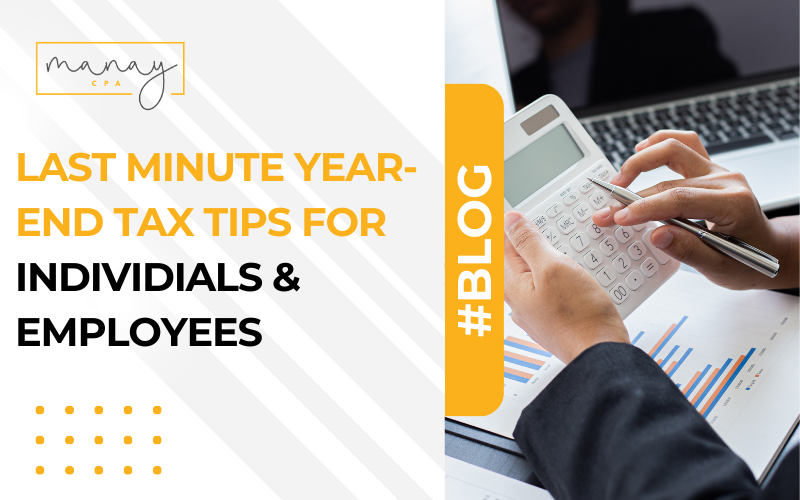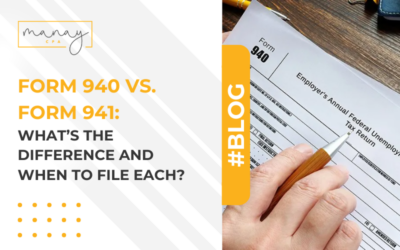Last-Minute Tax Tips For Individuals&Employees

With the year ending, this could be the perfect time to consider taxes. While tax season may seem far away, the decisions you make now can significantly impact your tax return. So, whether you’re an individual taxpayer or an employee, there are strategies that may help you optimize your taxation. And that’s what we’ll discuss throughout this guide – giving inciteful last-minute tax tips for individuals and/or employees.
Table of Contents
ToggleMaximizing Your Retirement Contributions
One of the most effective ways to reduce taxable income is by maximizing contributions to retirement accounts. That’s because the money you contribute to your retirement savings account is typically deducted from your income before taxes are applied. Contributions to 401(k)s, IRAs, and other retirement plans are often tax-deductible. By contributing the maximum allowed amount, individuals save for their future and lower their taxable income for the current year.
The Impact on Your Taxable Income
Suppose you’re an employee earning $75,000 annually and decide to contribute $10,000 to your traditional IRA. This contribution would reduce your taxable income to $65,000 for the year. So, if you’re in the 22% tax bracket, this reduction could save you $2,200 in taxes.
An added advantage is that the funds in your retirement account grow tax-free over time, so you will only owe taxes on the account’s growth once you start making withdrawals during retirement. And at that point, you might be in a lower tax bracket.
Remember that there are different retirement accounts, such as 401(k)s, traditional IRAs, and Roth IRAs, each with tax implications. Notably, optimizing your s for tax purposes is a complex process, and it’s always a good idea to consult a tax professional for advice on which is best suited for you.
Harvesting Investment Losses for Tax Savings
No one likes to see their investments lose value, but there’s a silver lining when they factor into your taxes. This is where the strategy of “harvesting” investment losses comes into play. Harvesting the losses can provide a valuable tax-saving approach. It’s all about turning a negative into a positive! This strategy involves selling investments at a loss to offset capital gains, thereby reducing the overall tax liability.
Ideally, harvesting investment losses helps limit the recognition of short-term capital gains, generally taxed at higher federal income tax rates than long-term capital gains. However, remember that the IRS applies specific rules to this practice, known as the “wash-sale” rule. This rule prohibits you from claiming a loss on the sale of an investment and then buying the same or a “substantially identical” investment within 30 days before or after the sale.
Education Tax Credits
If you have eligible education expenses, education tax credits can provide significant savings – especially if you’re currently paying for higher education. You can take advantage of two main types of education tax credits: the American Opportunity Tax Credit (AOTC) and the Lifetime Learning Credit (LLC).
AOTC provides up to $2,500 per eligible student for the first four years of post-secondary education, while LLC offers a tax credit of up to $2,000 per tax return for qualified education expenses. However, unlike the AOTC, the LLC has no limit on how many years it can be claimed. It is available for all post-secondary education years and courses to acquire or improve job skills. Income limits also apply.
Prepaying for the 2024 Spring Semester
Consider prepaying expenses for the 2024 spring semester before the end of the year to maximize tax benefits. If you intend to attend school in the spring semester of 2024, you could prepay your tuition fees before 2023 ends. This ensures you claim the education credit for 2023, reducing your tax liability for the current year.
Electric Vehicle Credits for Qualified Individuals
Also known as the Plug-In Electric Drive Vehicle Credit, the electric vehicle credit is a federal tax credit of up to $7,500 for those purchasing a qualifying electric vehicle. So, if you’ve purchased a qualified electric vehicle in 2023 or intend to buy one in 2024, you may be eligible for tax credits. Note that these credits vary based on factors such as the vehicle’s battery capacity and overall efficiency.
Electric Vehicle Credits Qualifications and Benefits
You can apply for the credit on your federal tax return if you purchase a new, eligible electric vehicle. And since the credit is nonrefundable, it can reduce your tax liability to zero, but you won’t receive a refund for any remaining credit.
The qualifications for the electric vehicle credit are primarily based on the type of vehicle and its battery capacity. To qualify, the vehicle must:
- Be new (used cars are not eligible)
- Be propelled to a significant extent by an electric motor which draws electricity from a battery.
- Have a battery capacity of at least 4 kilowatt hours.
- Be used predominantly within the United States.

Health Savings Account (HSA)
A Health Savings Account (HSA) is a type of savings account that allows you to set aside money on a pre-tax basis to pay for qualified medical expenses. It will enable you to save for medical expenses on a tax-advantaged basis since contributions are tax-deductible, and withdrawals for qualified medical expenses are tax-free, allowing you both short-term and long-term tax benefits. You can significantly lower your overall healthcare costs if you use untaxed income in an HSA to pay for deductibles, copayments, coinsurance, and other medical-related expenses.
Advantages of HAS
HSAs have several key tax benefits:
- Contributions are tax-deductible: Contributions to your HSA are deducted from your gross income.
- Withdrawals for qualified medical expenses are tax-free: If you use your HSA to pay for qualified medical expenses, the leaves are tax-free.
- Interest and other earnings are tax-free: Any interest or other payments on the money in your HSA are tax-free.
However, note that annual limits exist on how much you can contribute to an HSA. In 2023, the limits are $3,650 for individuals and $7,300 for families. And if you’re 55 or older, you can contribute an additional $1,000. So, if you haven’t donated to your HSA yet, consider doing so before the year ends.
Take Advantage of 80% Bonus Depreciation.
Bonus depreciation is a tax incentive allowing business owners to instantly deduct a significant percentage of the purchasing price of all eligible physical assets, such as machinery. This is as opposed to writing them off over their “useful life.” And since bonus depreciation is usually deducted immediately during the first year the depreciable item is placed in service, it allows you to drastically reduce taxable income for the year.
Based on the current Tax Cuts and Jobs Act (TCJA), you can deduct up to 80% of the purchasing price of any property placed in service after December 31, 2022, and before January 1, 2024. And for tax planning purposes, note that after December 31, 2023, and before January 1, 2025, the bonus depreciation will drop from 80% to 60%.
Charitable Donations for Tax Deductions
While charitable donations are about supporting worthy causes, they also provide significant tax benefits for the donors. Firstly, ensure that contributions are made to qualified charitable organizations and keep detailed records for tax documentation – you can itemize deductions on your tax return.
Generally, you can deduct contributions up to 50% of your adjusted gross income if you itemize your charitable donation deductions. However, the exact percentage can vary depending on the type of donation and the organization you’re donating to. For example, the limit is 60% of your adjusted gross income when contributing cash to public charities. At the same time, the maximum charitable deduction for donations of appreciated assets is 30% of your adjusted gross income.
So, to maximize these benefits, consider the following strategies:
- Donate Appreciated Assets: Instead of selling an appreciated asset and then donating the cash, consider donating the support directly to the charity. That means you won’t pay capital gains tax on the appreciation and still deduct the asset’s total market value.
- Qualified Charitable Distributions: If you’re over 70.5 years old and have an IRA, you can make a qualified charitable distribution directly from your IRA to a charity. This distribution won’t be included in your taxable income and can satisfy your required minimum distribution.
- Donor-Advised Funds: Contributing to a donor-advised fund allows you to make a charitable contribution and receive an immediate tax deduction
So, if you still need to, consider making last-minute donations to eligible charities and enjoy the dual benefit of giving back and reducing your 2023 taxable income.
Conclusion
These last-minute tax tips offer individuals and employees strategic ways to minimize their tax liability before the year concludes. Each of these strategies offers unique benefits and considerations, and it’s essential to understand how they apply to your specific situation. However, this guide is not a substitute for tax advice from tax professionals. Remember that tax laws are complex, subject to change, and individual circumstances vary. Consult tax professionals to ensure you maximize your opportunities and stay compliant with the law.

Published on: 18 December 2023
Last updated on: 19 December 2023
Manay CPA is a reputable, full-service CPA firm based in Atlanta, Georgia. Founded in 2001, we provide comprehensive accounting and tax solutions to individuals and businesses across all 50 states.





